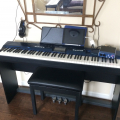Loopy Pro: Create music, your way.
What is Loopy Pro? — Loopy Pro is a powerful, flexible, and intuitive live looper, sampler, clip launcher and DAW for iPhone and iPad. At its core, it allows you to record and layer sounds in real-time to create complex musical arrangements. But it doesn’t stop there—Loopy Pro offers advanced tools to customize your workflow, build dynamic performance setups, and create a seamless connection between instruments, effects, and external gear.
Use it for live looping, sequencing, arranging, mixing, and much more. Whether you're a live performer, a producer, or just experimenting with sound, Loopy Pro helps you take control of your creative process.
Download on the App StoreLoopy Pro is your all-in-one musical toolkit. Try it for free today.
“Dark Passage”
Synths:
2 VividShapers
1 Tomofon
1 Speldosa
1 Roli Noise
Audio FX:
Binaural Locator (I covet 3D FX and this helps scratch that itch for IOS)
AltiSpace 2
Stereo Delay (1)
EOS 2 Reverb (Valhalla Designer on IOS)
MIDI FX:
2 Riffers (still my king of “roll the die” generators)
C Diminshed contains paranoia, tension and release, vertigo and ambiguity because it’s also Eb, F# and A diminshed… just select a root in Riffler and you’re there and I hope you can get out.



Comments
Cinematic, ominous were words that came to mind when listening, nice! Btw, don't you mean Riffer (Audiomodern)? Riffler is the guitar generator/ai (it would work too so maybe I'm the one wrong(?))
Oops. I do mean Riffer! It’s alway providing useful results. I run 2 or more instances and dial-in a bass part and a melodic upper part at a minimum. In this case I added some keyboard chord work.
I’ll edit the lead Post.
Thanks for the feedback and heads up.
sounds just great
Definitely cinematic. And Speldosa can be remarkably creepy in the right context, as here.
I’ve not tried Binaural Location, but it’s now on my list. The spatial design here is superb.
That moment before the big storm, you are on the horizon without any direction and way to escape. Would you stay and admire the magnificence of the dark clouds devouring the last pieces of the daylight or just run away hoping for the best. That's the feeling I got listening to ‘Dark Passage’, wonderful, thanks for sharing! 🤩
Thanks. Nothing close to your epic creations but my approach is to just build things in AUM on the sofa while the cat turns on the piano to get my attention for his next meal.
It’s like panning with that addition dimension of depth. The stereo focus points travel in elliptical orbits around two poles and you can vary the rate if the orbit. It adds more space to the results. With two instances I varied the rates for more complexity in the results.
Thanks for creating the screen play to match the score. You shoot, I score.
Or you could always consider it a new soundtrack for this…
“ Vincent Parry (Humphrey Bogart) has just escaped from prison after being locked up for a crime he did not commit -- murdering his wife. On the outside, Vincent finds that his face is betraying him, literally, so he finds a plastic surgery to give him new features. After getting a ride out of town from a stranger, Vincent crosses paths with a young woman (Lauren Bacall) who lets him stay in her apartment while he heals and continues to try and clear his name.”
It would definitely work! Excellent slice of the deepest black, with a very orchestral/soundtrack vibe.
Those Noir films usually had great film scores to set the mood. Bogie and Bacall… my subconscious hit pay dirt with this title but I’d never claim the honor of a classic Hollywood score from the Alfred Newman era (Randy’s Uncle as I recall).
This movie’s score came from Franz Waxman:
Brilliant arrangement - very creepy and suspenseful! I like it!
Wow, @McD ! So cinematic, loving this! A piece for an unreleased movie! The Octotonic rules !
Thanks… I’ve seen how you labor over your scores in StaffPad so I’m getting that Imposter Syndrome feeling… I fight it off by telling myself that I have just optimized the art of being lazy. I’m sticking to it and will ask ChatGPT to write my best-selling Self-Help book. When I get a spare moment from posting here. (Googles “how to prompt ChatGPT for a book that can pass an editor and legal review for authorship and not be riddled with inaccuracies”… see Sarah Silverman).
I don't struggle with my scores. I am actually having fun and stop when I get bored. Imposter? Why ? Only the result counts. If a piece sounds great and is evocative, who cares if you spent 2 hours or 20+ on it ?
Dittos to all the above. Excellent!
Who knows how Midjourney will visually interpret that scene description?! But one thing is for sure, AI will never be able to express true feelings and experience listening to music. 🤔
Can I ditto Pauls ditto?
You can make Xerox copies of Paul’s ditto and pass them out on the street. Congrats on SoundCloud pushing your work out… you deserve the extra listens.
If they’re real people and real plays I’m happy, if they’re bits of (in) silicon sniggering at their little AI jokes ☹️